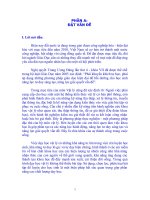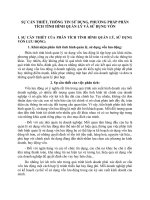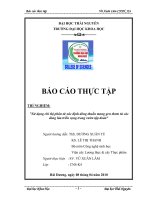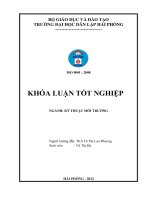Sử dụng chỉ số phân loại tính cách myers MBTI để đánh giá tính cách bản thân e (1)
Bạn đang xem bản rút gọn của tài liệu. Xem và tải ngay bản đầy đủ của tài liệu tại đây (128.96 KB, 8 trang )
He (She) just use some sort of a Myers-Briggs (MBTI) to assess:
1. His (Her) own personality?
2. Personality of a group of his (her) closest friends?
3. Personality of his (her) colleagues?
4. Personality of his (her) direct boss?
5. The importance of personal marketing in OB.
Based on the answers, He (she) will be categorized according personality synthesis:
- Extraverted - E
- Introverted - I
- Sensing - S
- Intuition - N
- Thinking - T
- Feeling - F
- Judging - J
- Perceiving – P
TASK
Myers-Briggs Type Indicator (MBTI) was developed nearly 60 years ago by Katharine Cook
Briggs and her daughter, Isabel Briggs Myers, along with the effective cooperation of
famous psychologist Swiss, Carl G. Jung.
MBTI was originally created so that people can make smartly decisions in career choosing
and help people understand the differences of normal personality types. Understanding the
diversity of different individual personality types will help people recognize and exactly
evaluate strengths and weaknesses of each person, so to answer the question of why no body
likes another.
Within the scope of this article, I will use the MBTI theory to assess and analyze the
personality problem of my own, my closest friend group, my colleagues, my direct boss and
finally, the importance of personal marketing in OB.
I. MBTI THEORY:
1. Concept: The MBTI is a method used to classify human personality with the following 4
criteria:
2
1.1. Natural trend: Extraversion / Introversion
2 This trend is opposite to the trend dealing with the outside world:
• Extraversion - towards the outside world, including the activities, people, objects.
• Introversion - turned inward, including thoughts, ideas and imagination.
These are two opposite but mutual trends. However, one of the two trends will prevail
in the development of personality and affect to behaviors.
1.2. Learn and perceive the world: Sensing / Intuition
There are two opposite trends about ways we receive information from the outside
world:
• Center "Sensing" in the brain to pay attention to the details associated with
images, sounds, smells ... of the current which are taken from the 5 senses of the
body. It classifies, arranges and records the details of the actual events taking place. It
also provides detailed information of the events that happened in the past.
• Central "Intuition" of the brain responsible for understanding, interpreting, and
formed the model from the information collected, sorted models and relating them to
each other. It helps the brain the ability to speculate and predict the future.
1.3. Decisions and choices: Thinking / Feeling.
There are two opposite trends of the way we make decisions and choices:
• The thinking of the human brain analyzes information objectively, works basing on
true/false, reasoning and concluded a systematic way. It is the logic of human nature.
• The brain's feeling decision based on the overall look, love/hate, interacting with
each other, and humanitarian values or aesthetics. That is the nature of human
subjectivity.
1. 4. Acting method: Judging / Perceiving
This is the way in which each person select to affect the outside world:
• Judging: access the world in a planned, organized, prepared way, and decided way,
to reach a clear outcome.
• Perceiving: approach the world in a natural way, to find ways to adapt to
circumstances, like an open ending, accept new opportunities, and accept to change
plans.
2. General characteristics:
I - INTROVERSION
E - EXTRAVERSION
3
• Think and consider carefully before action.
• Act first, then think and consider.
• There should be a significant private time
• Feeling miserable if they are isolated from
to charge the energy.
• Inspiration for the inner life, sometimes
the outside world.
• Interested in people and things around.
isolating themselves with the outside world • have a wide acquaintance, like contact with
• Like private conversation between 2 people
• Rarely active in asking for the opinions of
many other.
• Easy to get into conversations.
others.
S - SENSING
• Living with the present.
N - INTUITION
• Usually think about the future.
• Enjoy the simple solutions and practical.
• Use imagination, often create new
• Having a good memory for the details of
the events in the past.
• Good experience in applying.
• Comfortable with clear and reliable
information.
possibilities.
• Often only remember the main ideas and
relationships.
• Good in theory applying.
• Comfortable with ambiguity, or unclear
information.
T – THINKING
• Always look for facts and logic to draw
conclusions
• Tend to take care about tasks and works
which should be completed.
• Easy to make a thorough and objective
analysis.
F - FEELING
• Consider personal and emotional impact of
a decision on others before making a
decision.
• Sensitivity to the needs and responses of
others.
• Seek consensus and majority opinion.
• Accept conflict as a natural part of
• Bloopers of conflict, or have a negative
relationships between people.
J - JUDGING
• Have thorough plans before action.
reaction when disagreements occur.
P - PERCEIVING
• Can act without planning, scheduling,
• Focus on the activities of the task, complete
the important stages before continuing.
• Non-stress and well work when complete
the job before deadline.
• Self-set goals, deadlines, and standards to
manage life.
depending on the situation.
• Like to do many things at once, like the
variety, can both make and play.
• Take good pressure; work most effectively
when the job is going to expire.
• Try to avoid commitment if it affects the
flexibility, freedom and diversity of him.
4
The above mentioned factors in 4 trends of the criteria although conflict with each other, but
only to show the difference between humans and none of these factors is better than other.
3. Classification: From 4 above criteria, Briggs and Myers define 16 different groups of
personalities. The name of each group has 4 letters, represented for 4 classified criteria and
arranged as follows:
(The Duty Fullfiller)
(The Nurtures)
(The Protectors)
(The Scientists)
(The Mechanics)
(The Artists)
(The Idealists)
(The Thinkers)
(The Doers)
(The Perfomers)
(The Inspirers)
(The Visionaries)
(The Guardian)
(The Caregivers)
(The Givers)
(The Executives)
II. ASSESSMENT OF THE PERSONALITY AND THE IMPORTANCE OF
PERSONAL MARKETING IN OB:
1. My own personality:
In comparing with the elements of the criteria of the MBTI, I personally have found the
following characteristics:
5
- I'm easy to talk, interested in people, things and enjoy contact with people, through
that I compare my understanding of people that I learned from books with practical
exposure; I learned so many things from life. Thus, in terms of the criteria "natural
trend", I am the extrovert person (E).
- I tend to think of the future, often using imagination and combined with the
application of theory to a particular problem to think up new ideas. Thus, in terms of
the criteria "Learn and perceive the world", I am the intuition person (N).
- I'm always looking for facts and logical conclusions; I accept conflict as a natural part
of relationships between people. Thus, in terms of the criteria "decisions and
choices", I am the thinking person (T).
- I'm good under pressure, work most effectively when the job nearly expired; I usually
try to avoid commitment if it affects the flexibility, freedom of me. Thus, in terms of
the criteria "acting method", I am the perceiving person (P).
Synthesizing above judgments, my group of personality is ENTP (the visionary).
2. Personality of a group of my closest friends:
As mentioned above, I like the contact with so many people and I care about a lot of other
personality groups of MBTI to which enriches life and my knowledge of the man, but for the
group of closest friends, I tend to make friend with who has similar personality like me,
because this enables the exchange, feelings or sharing knowledge and experience among
close friends who have similar personality, will make a better friendship.
3. Personality of my colleagues:
According to the classification of the 16 MBTI personality group, people can make smart
decisions about career choice and help people understand the difference of normal
personalities. Understanding forms of different personalities that will help people to
recognize and evaluate the strengths and weaknesses of each person, relying on that people
can answer the question of why none like other.
Therefore, in my office, of a big business, the personality of whom I am interested in is a
group of people, who have suitable personality for works they have to complete, and
simultaneously can support and coordinate with other to accomplish common goals and
mission of the department.
6
4. Personality of my direct boss:
In comparing with the elements of the criteria of the MBTI, I noticed my direct boss have
the following characteristics:
- A type of thought and careful consideration before action, that's the kind of the
introvert person (I).
- Like the solutions simple and practical, applied experience better and comfortable
with the information clear and sure, that's the kind of the sensing person (S).
- Often search for facts and logical conclusions, accept conflict as a natural part of the
relationship between people, that's the kind of the thinking person (T).
- Have thorough planning before action, and works best when unstressed done ahead of
time, that's the kind of the judging person (J).
As such, his personality is ISTJ group (the duty fulfiller). Comparing personality between
him and me, and through long years working together, we can say that the relationship
between me and my boss have done quite well.
5. The importance of personal marketing in OB:
As we know, Organizational Behavior (OB) is a field study consists of 3 levels: individual,
group and collective, in which the object of study of OB is the study of the individual
effects, the groups and organizations for organizational behavior in order to apply this
knowledge to improve the efficiency of the organization.
Organizational behavior researchers interested in the way people behave and act in
organizations and its impact on the implementation of organizational tasks, especially those
related to behaviors such as job: absence, transfer, productivity, satisfaction of employees....
On the other hand, today's marketing concept is not only associated with products that can
be associated with any entity that: organizations, places ... even humans. Therefore, when an
individual belongs to a MBTI personality group and understanding the personality
characteristics of group that are building his or her own personal marketing in the
organization that he or she works for is an extremely important issue. For personal
marketing brings many benefits such individuals, as follows:
5.1. Personal Marketing has become an essential element to achieve a certain success in
the activities of an individual, especially in the organization of which he or she is
7
working for. Because of the good performance of a personal marketing help
superiors, colleagues or partners of people that have good reviews and positive
assessments of competence, character and job performance that he or she brings.
5.2. A good personal marketing help individuals better understand themselves, to help
increase the confidence and assertive. The process of personal marketing
development is the process of "spreading" the message, affirming the value of the
individual person.
Building a successful personal marketing also means that the person has a useful
tool to control oneself because of personal marketing is not merely to build a
personal image of the outside world (in general) and in an organization (in
particular), but it is also self-awareness of personal strengths, weaknesses, skills,
emotions ...
5.3. Make a difference: as well as commodity marketing, personal marketing when done
by a person in an organization is to determine the value of the individual, which
help distinguish individuals with others, as an individual who has created his own
brand, it is a useful tool that helps differentiate the individual from the peers in the
organization.
5.4. Bring tangible benefits in the short term as well as long-term (with better jobs,
stability, income growth, business expansion ...), because the ultimate goal of
building business or personal marketing is also sustainable development, is profit.
On the other hand, when an individual has good marketing and building a brand
famous, of course, he or she will have more opportunities in his or her field of
activity. For example, people would find Mr. A when needing financial advice or
will come to see Ms. B when getting advice on the management...
III. CONCLUSION:
Through the presentation of the above criteria, characteristics and classification of the MBTI
personality group, assessment and analysis of the personality’s issues and the importance of
personal marketing in the OB, we seen tremendous value of MBTI applications in selfassessment of each person, helping each person understand which personality they have, and
understand the differences of the different groups, observe the diversity different
personalities. From there, evaluate the strengths and weaknesses of one’s own (in particular)
and of other people (in general), and the individual proposed for building a personal
8
marketing that suit his or her organization, in order to achieve the best benefits for himself or
herself as well as for the organization. /.
____________________________________









